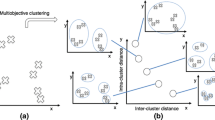Abstract
This paper compares the results obtained for four single clustering algorithms with a multi-objective clustering approach. For this, a dataset describing the student’s behavior within the Linear Algebra topic on the MathE e-learning platform is used. This dataset aids in understanding student performance and engagement in MathE to support the development of an intelligent system to tailor the platform’s resources to users’s needs. The four algorithms suggested two clusters as the optimal solution for the dataset. However, this binary categorization did not provide meaningful insights into the proposal of the MathE platform; that is, it did not provide a customized system according to individual needs. Thus, this study uses the multi-objective clustering algorithm, which results in a set of non-dominated solutions, providing decision-makers with a broader range of options to choose the solution that best meets their needs. The results demonstrate the main benefits of the proposed human-in-the-loop multi-objective approach since it provides several optimal solutions and allows the decision-maker to apply fundamental knowledge to define the most appropriate solution to the problem based on previous knowledge.
This work has been supported by FCT Fundação para a Ciência e Tecnologia within the R&D Units Project Scope UIDB/00319/2020, UIDB/05757/2020 (DOI: 10.54499/UIDB/057 57/2020), UIDP/05757/2020 (DOI: 10.54499/UIDP/05757/2020) and Erasmus Plus KA2 within the project 2021-1-PT01-KA220-HED-000023288. Beatriz Flamia Azevedo is supported by FCT Grant Reference SFRH/BD/07427/2021.
Access this chapter
Tax calculation will be finalised at checkout
Purchases are for personal use only
Similar content being viewed by others
References
Aggarwal, C.C., Reddy, C.K.: Data Clustering Algorithms and Applications. CRC Press, Taylor & Francis Group (2013)
Arbelaitz, O., Gurrutxaga, I., Muguerza, J., Pérez, J.M., Perona, I.: An extensive comparative study of cluster validity indices. Pattern Recogn. 46(1), 243–256 (2013)
Azevedo, B.F., Rocha, A.M.A.C., Fernandes, F.P., Pacheco, M.F., Pereira, A.I.: Evaluating student behaviour on the MathE platform - clustering algorithms approaches. In: (In press) Book of 16th Learning and Intelligent Optimization Conference - LION 2022, Milos, Greece, pp. 319–333 (2022)
Azevedo, B.F., Leite, G., Pacheco, M.F., Fernandes, F.P., Rocha, A.M.A.C., Pereira, A.I.: Multi-objective clustering algorithm applied to the MathE categorization problem. Submitted to Information Systems Frontiers
Azevedo, B.F., Rocha, A.M.A.C., Pereira, A.I.: Hybrid approaches to optimization and machine learning methods: a systematic literature review. J. Mach. Learn. (2024)
Azevedo, B.F., Rocha, A.M.A.C., Pereira, A.I.: A multi-objective clustering algorithm integrating intra-clustering and inter-clustering measures. In: Book of 4th International Conference in Optimization and Learning. Communications in Computer and Information Science. Springer (2024, in press)
Caliński, T., Harabasz, J.: A dendrite method for cluster analysis. Commun. Stat. 3(1), 1–27 (1974)
Coello-Coello, C.A., Lechuga, M.S.: MOPSO: a proposal for multiple objective particle swarm optimization. In: Proceedings of the 2002 Congress on Evolutionary Computation, CEC 2002 (Cat. No. 02TH8600), vol. 2, pp. 1051–1056 (2002)
Deb, K.: Multi-Objective Optimization Using Evolutionary Algorithms. Wiley, Hoboken (2001)
Dunn, J.C.: A fuzzy relative of the isodata process and its use in detecting compact well-separated clusters. J. Cybern. 3(3), 32–57 (1973)
Dutta, D., Sil, J., Dutta, P.: Automatic clustering by multi-objective genetic algorithm with numeric and categorical features. Expert Syst. Appl. 137, 357–379 (2019)
Ferligoj, A., Batagelj, V.: Direct multicriteria clustering algorithms. J. Classif. 9(1), 43–61 (1992)
Handl, J., Knowles, J.: An evolutionary approach to multiobjective clustering. IEEE Trans. Evol. Comput. 11(1), 56–76 (2007)
Jain, M., Jain, M., AlSkaif, T., Dev, S.: Which internal validation indices to use while clustering electric load demand profiles? Sustain. Energy Grids Netw. 32, 100849 (2022)
MacQueen, J.B.: Some methods for classification and analysis of multivariate observations. In: Proceedings of the Fifth Berkeley Symposium on Mathematical Statistics and Probability, vol. 1, pp. 281–297. University of California Press (1967)
Raschka, S., Mirjalili, V.: Python Machine Learning. Packt Publishing (2015)
Rokach, L., Maimon, O.: Clustering methods. In: Maimon, O., Rokach, L. (eds.) Clustering Methods Data Mining and Knowledge Discovery Handbook (2005)
Sokal, R.R., Michener, C.D.: A statistical method for evaluating systematic relationships. Univ. Kans. Sci. Bull. 38, 1409–1438 (1958)
Sorensen, T.A.: A method of establishing groups of equal amplitude in plant sociology based on similarity of species content and its application to analyses of the vegetation on Danish commons. Biol. Skar. 5, 1–34 (1948)
Yapiz: Evolutionary clustering and automatic clustering (2022). https://www.mathworks.com/matlabcentral/fileexchange/52865-evolutionary-clustering-and-automatic-clustering. Accessed 2 Feb 2022
Author information
Authors and Affiliations
Corresponding author
Editor information
Editors and Affiliations
Rights and permissions
Copyright information
© 2024 The Author(s), under exclusive license to Springer Nature Switzerland AG
About this paper
Cite this paper
Azevedo, B.F., Rocha, A.M.A.C., Fernandes, F.P., Pacheco, M.F., Pereira, A.I. (2024). Comparison Between Single and Multi-objective Clustering Algorithms: MathE Case Study. In: Pereira, A.I., et al. Optimization, Learning Algorithms and Applications. OL2A 2024. Communications in Computer and Information Science, vol 2280. Springer, Cham. https://doi.org/10.1007/978-3-031-77426-3_5
Download citation
DOI: https://doi.org/10.1007/978-3-031-77426-3_5
Published:
Publisher Name: Springer, Cham
Print ISBN: 978-3-031-77425-6
Online ISBN: 978-3-031-77426-3
eBook Packages: Intelligent Technologies and RoboticsIntelligent Technologies and Robotics (R0)




